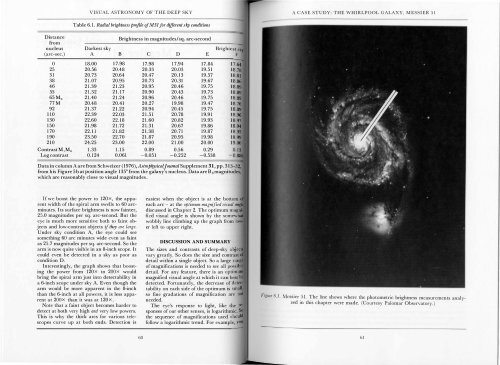OF THE ROGER N. CLARK
OF THE ROGER N. CLARK
OF THE ROGER N. CLARK
Create successful ePaper yourself
Turn your PDF publications into a flip-book with our unique Google optimized e-Paper software.
VISUAL ASTRONOMY <strong>OF</strong> <strong>THE</strong> DEEP SKY<br />
A CASE STUDY: <strong>THE</strong> WHIRLPOOL GALAXY, MESSIER 51<br />
Table 6.1. Radial brightness profile if M51 for different sky conditions<br />
-<br />
Distance<br />
from<br />
Brightness in magnitudes/sq. arc-second<br />
nucleus Darkest sky<br />
(arc-sec.) A B C D E<br />
0 18.00 17.98 17.98 17.94 17.84<br />
25 20.56 20.48 20.33 20.03 19.5 1<br />
31 20.73 20.64 20.47 20.13 19.57<br />
38 21.07 20.95 20.73 20.31 19.67<br />
46 21.39 21.23 20.95 20.46 19.75<br />
55 21.32 21.17 20.90 20.43 19.73<br />
65 Mo 21.40 21.24 20.96 20.46 19.75<br />
77 M 20.48 20.41 20.27 19.98 19.47<br />
92 21.37 21.22 20.94 20.45 19.75<br />
110 22.39 22.03 21.51 20.78 19.91<br />
130 22.60 22.18 21.60 20.82 19.93<br />
150 21.98 21.72 21.31 20.67 19.86<br />
170 22.11 21.82 21.38 20.71 19.87<br />
190 23.50 22.70 21.87 20.95 19.98<br />
210 24.25 23.00 22.00 21.00 20.00<br />
Contrast M,Mo 1.33 1.15 0.89 0.56 0.29<br />
Log contrast 0.124 0.061 -0.051 -0.252 -0.538<br />
Data in column A are from Schweizer (1976), Astrophysicaljoumal Supplement 31, pp. 31<br />
from his Figure 5b at position angle 1350 from the galaxy's nucleus. Data are B3 magnitudes,<br />
which are reasonably close to visual magnitudes.<br />
If we boost the power to 120 x, the apparent<br />
width of the spiral arm swells to 60 arcminutes.<br />
Its surface brightness is now fainter,<br />
25.0 magnitudes per sq. arc-second. But the<br />
eye is much more sensitive both to faint objects<br />
and low-contrast objects if they are large.<br />
Under sky condition A, the eye could see<br />
something 60 arc minutes wide even as faint<br />
as 25.7 magnitudes per sq. arc-second. So the<br />
arm is now quite visible in an 8-inch scope. It<br />
could even be detected in a sky as poor as<br />
condition D.<br />
Interestingly, the graph shows that boosting<br />
the power from 120 X to 200 X would<br />
bring the spiral arm just into detectability in<br />
a 6-inch scope under sky A. Even though the<br />
arm would be more apparent in the 8-inch<br />
than the 6-inch at all powers, it is less apparent<br />
at 200x than it was at 120x.<br />
Note that a faint object becomes harder to<br />
detect at both very high and very low powers.<br />
This is why the thick arcs for various telescopes<br />
curve up at both ends. Detection is<br />
easiest when the object is at the bottom<br />
each arc - at the optimum magnified visual<br />
discussed in Chapter 2. The optimum<br />
fied visual angle is shown by the<br />
wobbly line climbing up the graph from<br />
er left to upper right.<br />
DISCUSSION AND SUMMARY<br />
The sizes and contrasts of deep-sky<br />
vary greatly. So does the size and contrast<br />
detail within a single object. So a large<br />
of magnifications is needed to see all<br />
detail. For any feature, there is an<br />
magnified visual angle at which it can best<br />
detected. Fortunately, the decrease of<br />
tability on each side of the optimum is<br />
so fine gradations of magnification are<br />
needed.<br />
The eye's response to light, like the<br />
sponses of our other senses, is logarithmic.<br />
the sequence of magnifications used<br />
follow a logarithmic trend. For example,<br />
Figure 6.1. Messier 51. The line shows where the photometric brightness measurements analyzed<br />
in this chapter were made. (Courtesy Palomar Observatory.)<br />
60<br />
61











